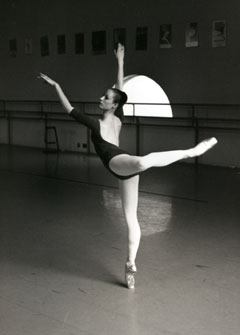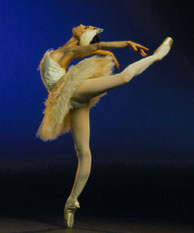
昨天介紹過芭蕾舞的Arabesque, 今天想說是一個更漂亮的pose, 就是Attitude.
Attitude[a-tee-TEWD](American Ballet Theatre): A particular pose in dancing derived by Carlo Blasis from the statue of Mercury by Giovanni da Bologna. It is a position on one leg with the other lifted in back, the knee bent at an angle of 90 degrees and well turned out so that the knee is higher than the foot. The supporting foot may be a terre, sur la pointe or sur la demi-pointe. The arm on the side of the raised leg is held over the head in a curved position while the other arm is extended to the side. There are a number of attitudes according to the position of the body in relation to the audience.

 Friends of Hong Kong Ballet:
Friends of Hong Kong Ballet: 這是最早期的古典芭蕾舞舞姿,是十九世紀初一位偉大芭蕾舞老師卡羅.布拉西斯 (Carlo Blasis) 經過認真研究,而訂定出來的一系列芭蕾舞舞姿之一。這舞姿是參照十六世紀一位法蘭德斯混意大利裔的雕塑家喬凡尼.達.博洛尼亞 (Giovanni da Bologna) 的著名作品《使神墨丘利》 (statue of Mercury) 的形象而創作出來。
就如「阿拉伯舞姿」Arabesque, 這舞姿是十分鮮明簡單,要求的是手臂與提升起的腿的相互配合的動作。一般來說,是動力腿向後 (derriere) 或向前 (devant) 提升,其中膝部會彎成約 90度,或因應身體的方向而調較。
最重要是保持兩腿間最大幅度的髖外轉。於向前 (devant) 提升的動作中,舞蹈員會盡量將腳部配合膝部向上提升至同一水平。無論是向前或向後提腿,舞蹈員也不能讓主力腿的盆骨傾側。手臂的運作 (port de bras) 也要作整體的配合,雖然,通常在同一側的手和腿會一同提升,但也要按腿部及身體的方向而作出相應的調整,以保持姿勢優美。這舞姿看似簡單,但要讓身保持雕像姿的優美並不容易。
事實上,雕像姿有十多個的變化,一些甚富戲劇性,但也有"放肆 " 一點的。於男或女的獨舞段中,我們也常會看到雕像姿,在雙人舞 pas de deux 中,我們也常看到女舞者作下傾雕像姿 (Attitude penchee) ;即女舞者的身體下傾,動力腿向後提升輕纏著她的舞伴,讓她的舞伴扶著她以主力腿的腳尖支撐著整個身體旋轉。最明顯的例子就是《睡美人》裡的玫瑰慢板,當四位王子向愛麗娜公主致敬後,公主以單足尖保持整個身體平衡並同時提起雙臂,是傳統古典芭蕾舞的「雕像姿」。對於女舞者而言,是一項技巧上的測試。
Technorati tags: attitude, ballet posture, ballet term
No comments:
Post a Comment